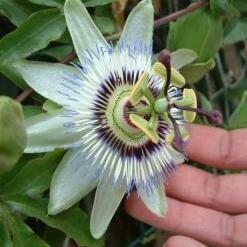Climbing herbs or lianas with axillary tendrils, rarely shrubs or trees, vegetative ramification through a supra-axillary bud. Leaves alternate (rarely subopposite), spirally arranged, simple or rarely compound, stipulate or not, petiolate, petiole or base of blade often with 1 to many glands; leaf blade entire or lobed, venation pinnate or palmate, often with glands on margin and abaxial surface. Inflorescence cymose, axillary, sessile or pedunculate, primary axis often a tendril, secondary axis often reduced; bracts minute to foliaceous, sometimes glandular. Pedicels articulate distal to bracts. Flowers mostly actinomorphic, bisexual, functionally unisexual, or polygamous; perianth persistent, segments free or partially fused at base. Sepals (3-)5(or 6). Petals (3-)5(or 6), imbricate. Corona inserted on hypanthium, composed of filaments or hairs often in multiple series. Stamens (4 or)5(-60), inserted on androgynophore or at base of hypanthium; filaments free to base or sometimes partially fused; anthers dorsifixed, 2-celled, dehiscing via longitudinal slits, sometimes with apical appendage. Ovary (1-)3(-5)-carpellate, superior, 1-loculed, sessile or stipitate on elongate androgynophore; placentation parietal; ovules many, anatropous; styles (1-)3(-5), free to partially fused at base; stigmas globose, capitate, papillate, or divided. Fruit a berry or loculicidally 3(-5)-valved capsule. Seeds numerous, compressed, often beaked, enclosed by fleshy aril; testa reticulate or pitted; endosperm copious, oily; embryo straight; cotyledons foliaceous.
Herbs, shrubs, trees (not in Australia) or vines with axillary tendrils. Stipules present or absent (not in Australia). Leaves alternate, rarely opposite (not in Australia), simple, lobed, digitate or pinnate (not in Australia), often with glands functioning as extrafloral nectaries on the lamina and petiole; stipules present or absent (not in Australia), small and setaceous to large and herbaceous. Inflorescence a terminal raceme or panicle (not in Australia) or an axillary cyme, 1–many-flowered, sometimes resembling a raceme, often bracteate. Flowers actinomorphic, rarely zygomorphic (not in Australia), bisexual or unisexual, with a cup-shaped to tubular hypanthium. Sepals and petals usually 5, rarely petals absent, free or basally connate. Corona absent or present on hypanthium and consisting of 1 or more whorls of filaments, scales or teeth. Stamens (3–) 5 (–10), adnate to hypanthium or fused into an androgynophore; filaments free at least near ends; anthers 2-locular, dehiscing by longitudinal slits. Ovary superior, often on a gynophore or androgynophore, unilocular, (2–) 3 (–7)-carpellate; placentation parietal; ovules 1–many. Styles (1–) 3 (–7). Fruit a berry or loculicidal capsule; seeds 1–many, with or without (not in Australia) an aril, with endosperm.
Vines [shrubs, trees], perennial [rarely annual], woody or herbaceous, with [without] tendrils; axils with multiple axillary buds, primary axillary bud often developing into inflorescence or tendril; bark smooth to rough or corky. Leaves alternate, simple [rarely compound], often of floral tube as 1–7[–ca. 15] series of filaments or outgrowths, sometimes membranous; extrastaminal nectary disc often present; stamens [4–]5[–ca. 25], usually borne on androgynophore [hypanthium]; ovary superior, [2–]3[–5]-carpellate, 1-locular, usually borne on androgynophore; placentation parietal; styles distinct [variously connate]; stigmas capitate or clavate to reniform, sometimes 2-lobed [fimbriate]. Fruits baccate or capsular. Seeds (1–)3–ca. 200, arillate, usually compressed, surface usually pitted to reticulate or grooved.
Ovary superior, 3–5(6)-carpellar, 1-locular, often stipitate (borne on an androgynophore) or rarely subsessile; ovules many or few, on 3–5(6) parietal placentas, pendulous, anatropous, with the funicle elongate; styles 1 or 3-5, with capitate or clavate, sometimes fimbriate stigmas
Stamens 5, rarely 6–10 or ?; filaments free or partially connate into a tube, inserted at the base of the flower or on an androgynophore; anthers oblong or linear, basifixed or dorsifixed, introrse, 2-locular, dehiscing by longitudinal slits, sometimes apiculate
Leaves alternate, rarely opposite, entire or variously lobed or 3–7-foliolate, sessile or petiolate, often with glands at the margin and on the abaxial surface of the lamina and at the apex of the petiole
Seeds 1–?, on long funicles, ovate, compressed, rarely oblong or tumid, mostly arillate, with a furrowed and ridged seed-coat; endosperm fleshy, more or less abundant
Stamens 5 or more, hypogynous or perigynous, shortly united or in bundles, sometimes springing from the gynophore; anthers 2-celled, opening lengthwise
Corona annular, single or double, rarely 0, tubular and often fimbriate at the margin with the laciniae erect or radiant, or reduced to a rim of hairs
Petals 0 or as many as the calyx-lobes, inserted at the base or mouth of the calyx-tube or in an intermediate position, the margin entire or fimbriate
Ovary superior, 1-celled, with 3 or rarely 4–5 parietal placentas; ovules usually numerous; styles free or united; stigmas often capitate
Calyx-tube short or ± elongate, coriaceous or herbaceous; lobes 3–? (3–6 in FZ species), valvate or imbricate, persisting with the tube
Flowers solitary, in racemes or in paniculate cymes, pedicellate, the pedicel often articulate and 3-bracteolate
Leaves alternate, entire or lobed, often with a glandular petiole; stipules usually small and deciduous
Trees, shrubs or herbs, erect or more usually tendrillous climbers, sometimes with a napiform root
Tendrils, when present, axillary (sterile peduncles) or at the apex of the floriferous peduncle
Seeds with pitted testa, surrounded by a pulpy aril; endosperm fleshy; embryo large, straight
Corona of one or more rows of thread-like processes or scales, or annular
Flowers hermaphrodite or unisexual or polygamous, actinomorphic
Fruit a capsule or berry, indehiscent or loculicidally 3-valved
Herbaceous climbers bearing tendrils, or erect trees or shrubs
Fruit baccaceous or a 3–5-valved capsule, usually many-seeded
Embryo large, with leafy cotyledons and cylindrical radicle
Petals 5, rarely absent, free or shortly united, imbricate
Sepals 5, imbricate, persistent, free or partially united
False stipules present in some species of Basananthe
male flowers often with a vestigial ovary
Stipules 0 or 2, caducous or persistent
Hypanthium ± developed, broad or narrow
female flowers usually with staminodes
Flowers hermaphrodite or unisexual
Disk-glands sometimes present

